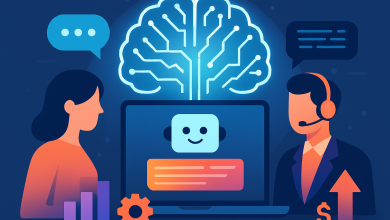
Introduction: From Hype to Enterprise Transformation
AI is no longer a distant frontier—it’s the engine reshaping the core of every industry. From precision marketing to sustainable aviation, every domain is undergoing a digital metamorphosis. The conversation is evolving beyond generative chatbots to a deeper, systemic transformation—Agentic AI. As we move into this new era, the true opportunity lies in designing AI that is ethical, explainable, and human-aligned.
What is Agentic AI?
Agentic AI refers to intelligent, autonomous systems that can break down complex goals into smaller sub-tasks, maintain memory across workflows, and adapt strategies in real time. Unlike traditional AI that generates text or predictions, agentic systems can take initiative and carry out tasks with little human input. These are digital agents—independent workers—booking travel, managing credit portfolios, or adjusting HVAC systems without constant oversight. In essence, they operate like intelligent software employees.
Why It Matters to Enterprises
As businesses face growing complexity, personalization demands, and real-time decision-making, Agentic AI stands out. It’s not just about saving time; it’s about scaling decisions, learning from outcomes, and adapting to ever-changing environments. Agentic AI brings a new layer of autonomy that bridges gaps between tools, teams, and tasks. This has profound implications across finance, retail, IT, and industrial sectors.
Key Differentiators: What Makes Agentic AI Unique
Agentic AI offers several foundational capabilities:
– Goal decomposition: Agents can transform a high-level goal into sequential, executable tasks.
– Persistent memory: Agents remember context from past interactions, unlike stateless LLMs.
– Autonomous reflection: They learn from feedback, errors, and performance metrics in real time.
– Dynamic orchestration: They can coordinate with APIs, databases, and other agents seamlessly.
For example, when tasked with driving $1M in sales, a basic LLM might generate an email. A true agentic system, however, would segment customers, personalize offers from CRM data, test variations, monitor conversions, and adapt its strategy—all autonomously.
Reference Architecture: How Agentic AI Works
Agentic AI platforms typically follow a modular design that includes:
– Agent marketplace: A repository of plug-and-play agents with documented skills
– Orchestration layer: Coordinates agents and aligns tasks across workflows
– Memory layer: Powered by vector stores, knowledge graphs, and finite state machines
– Governance layer: Enforces explainability, privacy, and compliance by design
This architecture allows enterprises to plug in agents like APIs or SaaS tools while maintaining oversight and compliance.
Real-World Impact Across Industries
Agentic AI is already redefining operations in multiple sectors:
– Banking & Finance: Agents monitor credit risk, track analyst sentiments, and propose branch optimizations using geospatial data.
– Retail: Campaign agents personalize promotions, execute A/B tests, and adapt to buyer behavior.
– Industrial operations: HVAC systems adjust energy use dynamically with RL-trained agents, optimizing both comfort and cost.
– IT service desks: Persona-specific agents assist leadership, HR, and field teams with contextual support and task execution.
Agent Discovery: The New Search Problem
As thousands of agents become available, a critical challenge emerges—how do enterprises find the right one for their needs? A proposed solution is a Learning-to-Rank (L2R) approach. This algorithm scores agents based on semantic alignment with user intents, regardless of vendor-specific descriptions. It enables intuitive, intelligent agent discovery at scale.
UX and Memory: Pillars of Adoption
Two often overlooked factors in enterprise AI adoption are user experience and memory:
– UX Personalization: Agents should adapt their tone, language, and interaction style based on user roles—what works for a VP might confuse an intern.
– Memory Design: Real enterprise memory includes semantic (facts), episodic (events), procedural (how-tos), and emotional (user sentiments)—not just token-level vectors.
Together, these ensure continuity, trust, and long-term engagement.
Bridging Structured and Unstructured Data
Modern enterprises operate with both structured (SQL) and unstructured (PDFs, emails, docs) data. Agentic AI bridges the gap using:
– Retrieval-Augmented Generation (RAG) pipelines for unstructured queries
– Text2SQL interfaces for structured databases
– Query fusion, the next frontier, allows agents to combine insights from both into cohesive answers
This means agents can respond to questions like, “What’s our top-performing product line, and how has customer sentiment evolved?” by integrating insights from dashboards and customer reviews simultaneously.
Reinforcement Learning: Optimizing the Real World
Some enterprise use cases demand more than static rules or predictions—they require dynamic learning and adaptation. That’s where Reinforcement Learning (RL) becomes essential. Agents can learn from rewards in real time, whether it’s reducing HVAC energy use or optimizing logistics costs. Today, LLMs are even helping design better reward functions, blending symbolic logic with neural learning.
Responsible AgentOps: Governance by Design
Autonomy demands accountability. As agents grow more capable, organizations must invest in responsible governance:
– Explainability: Use Chain-of-Thought (CoT) prompting and step-by-step logs
– Privacy: Protect both training and conversational data with encryption and access controls
– Fairness: Audit and curate datasets to reduce bias
– Accountability: Maintain human-in-the-loop systems for critical or regulated decisions
These elements should not be bolt-ons—they must be embedded at the architectural level.
The Road Ahead: Building a Responsible Agentic Enterprise
Agentic AI represents more than a technology trend—it’s a foundational shift. The convergence of autonomous execution, contextual intelligence, and scalable personalization offers enterprises a transformative edge. But without robust discovery frameworks, memory strategies, and ethical guardrails, such systems risk becoming brittle or biased.
This is the decade when agents will outnumber apps. The question is no longer if companies should adopt agentic AI—it’s how they can do so responsibly, scalably, and with human values at the center.





